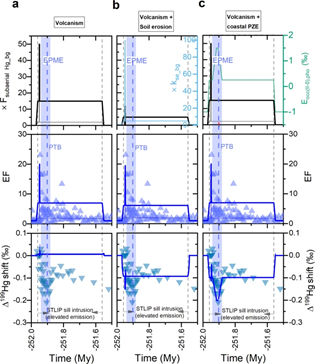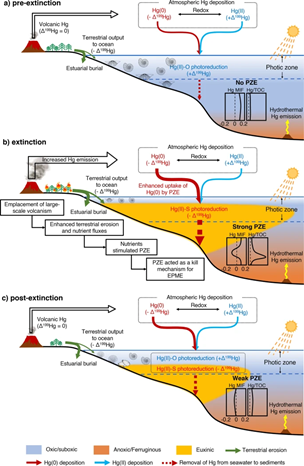A new mercury isotope model developed by Prof. Ruoyu Sun shows that the mercury isotope variations across the end-Permian mass extinction provide new evidence for marine photic zone euxinia, which was a major kill mechanism for the largest Phanerozoic biological crisis.
1. The purpose of our model is to improve the current interpretations of “mass extinction” using mercury isotopes
Mercury (Hg) stable isotope composition, especially the mass-independent fractionation of odd Hg isotopes (odd-MIF) is emerging as a powerful tracer of Hg sources (e.g., volcanic vs. non-volcanic) and pathways (e.g., atmospheric deposition vs. terrestrial erosion) in paleoenvironments, notably during the critical time of Phanerozoic mass extinctions. However, the prevailing paradigms of interpretating odd-Hg MIF in ancient sedimentary strata mainly emphasize the mixing of different Hg sources or end-members, lacking a full consideration on the impact of ocean redox conditions on Hg isotope variations. Multiple studies based on experimental and observational evidence have demonstrated that Hg isotopes show characteristic signatures in response to ocean redox changes (e.g., during the Mesoproterozoic Period and Late Devonian mass extinction), particularly the development of marine photic zone euxinia (PZE, sulfide-rich conditions in marine photic zone). PZE has been considered as a potent kill mechanism during almost all “The Big Five” mass extinction, and an obstacle to biotic recovery after mass extinction. Thus, interpreting Hg isotope signals in ancient sediments without considering the effects of redox conditions could lead to misinterpretation of the mechanism of biotic crises, and conceal the full potential of Hg isotopes as a novel paleoenvironment proxy.
2. The impact of our modelling lies in identifying and quantitatively evaluating photic zone euxinia as a main mechanism of Hg isotope variations in the end-Permian mass extinction
The end-Permian mass extinction (EPME) is marked by widespread Hg enrichment near the extinction boundary, which is considered as one of the most compelling pieces of evidence for the impact of volcanic activities on the EPME. In many marine sedimentary sections, the Hg enrichment was accompanied by negative shifts of Hg odd-MIF, which is typically interpreted as evidence of enhanced terrestrial erosion driven by volcanism. However, negative shifts of odd-MIF can also be caused by PZE. While there is already abundant evidence for PZE across the EPME based on lipid biomarkers of sulfur bacteria, the possibility that PZE caused Hg isotope shifts during this critical mass extinction has not been explored.
Volcanic activity, terrestrial erosion and PZE are inherently related during mass extinctions, as PZE was typically stimulated by global warming and enhanced terrestrial nutrient inputs, which were often triggered by volcanism. To understand the relationships between volcanic activity, terrestrial erosion and PZE and their effects on Hg isotope signatures in sedimentary rocks, we develop a fully-coupled deep-time Hg isotope box model that considers both Hg sources and processes. We apply this model to examine the cause of Hg isotope variations in sedimentary strata during the EPME. Our modelling suggests that while large-scale volcanism remains the main driver of widespread Hg enrichment, the negative shifts of Hg odd-MIF across the EPME cannot be fully explained by direct volcanism or terrestrial erosion as proposed previously. Instead, these negative shifts of odd-MIF are best explained by Hg isotope fractionations driven by PZE in coastal and open oceans. In addition, there exists a ~40 kyr time lag between the largest negative shift of odd-MIF and the spike of Hg enrichment in Meishan (GSSP) and many other marine sections, which was unexplained previously. Our model shows that PZE may lag behind the onset of volcanic eruptions and terrestrial erosion, thus further supporting PZE as the main driver of the negative shift of Hg odd-MIF in addition to terrestrial erosion across the EPME.
3. Our model sets the stage for the application of Hg isotopes as a powerful tool in tracing the co-evolution of ocean redox conditions and life
Our model indicates that the influence of PZE and potentially other ocean redox conditions on sedimentary Hg isotope signatures should be carefully evaluated in paleoenvironmental studies in addition to terrestrial erosion and volcanism. These three factors could operate in a combined and interactive way to cause sedimentary Hg enrichment and Hg isotope shifts. Our study also highlights that numerical model that fully couples Hg cycling and Hg isotope fractionation could help elucidate the complex relationships among volcanic activity, terrestrial weathering, and marine redox processes, and thus is a valuable approach for studying Hg cycling in deep time.
There are still many unanswered questions in the application of Hg isotopes in paleoenvironmental studies, such as the fractionation mechanisms of Hg isotopes in different redox settings, and the influence of diagenesis on sedimentary Hg enrichment and Hg isotope signatures, which should be investigated in the future. Nevertheless, our novel model reinforces the hypothesis that PZE acted as a key kill mechanism for the EPME, and paves the way of quantifying the effects of volcanism, terrestrial erosion, and ocean redox conditions on Hg isotope variations in deep time, which are critically important for the application of Hg isotopes in reconstructing the co-evolution of environment and life.


Article information:
Sun R., Liu Y., Sonke J. E., Zhang F., Zhao Y., Zhang Y., Chen J., Liu C.-Q., Shen S.Z.(沈树忠), Anbar A. D. and Zheng W.* (2023) Mercury isotope evidence for marine photic zone euxinia across the end-Permian mass extinction. Commun. Earth Environ. 4, 1–11.https://www.nature.com/articles/s43247-023-00821-6